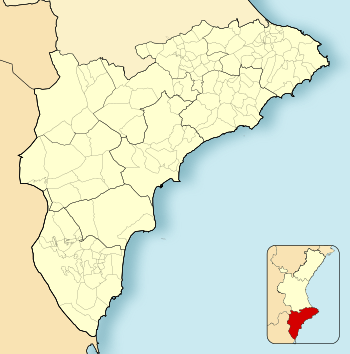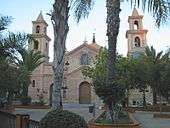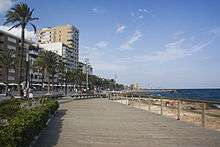Torrevieja
Torrevieja (Spanish: [ˌtoreˈβjexa]) or Torrevella (Valencian: [ˌtoreˈveʎa]) is a seaside city and municipality located on the Costa Blanca in the province of Alicante, on the southeastern Mediterranean coast of Spain.
Torrevieja | |
|---|---|
 Flag .svg.png) Coat of arms | |
 Torrevieja Location of Torrevieja  Torrevieja Torrevieja (Valencian Community)  Torrevieja Torrevieja (Spain) | |
| Coordinates: 37°58′40″N 0°41′0″W | |
| Country | |
| Autonomous community | |
| Province | Alicante |
| Comarca | El Baix Segura / La Vega Baja |
| Judicial district | Torrevieja |
| Founded | 20th century |
| Government | |
| • Mayor | José Manuel Dolón García (2015) (LV) |
| Area | |
| • Total | 71.44 km2 (27.58 sq mi) |
| Elevation | 7 m (23 ft) |
| Population (2018)[1] | |
| • Total | 82,599 |
| • Density | 1,200/km2 (3,000/sq mi) |
| Demonym(s) | Torrevejense |
| Time zone | UTC+1 (CET) |
| • Summer (DST) | UTC+2 (CEST) |
| Postal code | 03181 a 03188 |
| Dialing code | 965 and 966 |
| Official language(s) | Spanish |
| Website | www |
Torrevieja lies about 50 kilometres south of the city of Alicante and had a population of 90,097 at the 2011 Census; the latest official estimate (for 2019) is 83,337.[2] Torrevieja was originally a salt-mining and fishing village as it is located between the sea and two large salt lakes (Las Salinas), which give Torrevieja healthy microclimate.
History
Until 1802, Torrevieja existed only as an ancient guard tower, which gave the town its name (Torre Vieja (Spanish) means Old Tower) and some labourers' cottages. But in 1803, Charles IV authorised the movement of the salt production offices from La Mata to the town itself and allowed the construction of dwellings there. In 1829, the town was totally destroyed by an earthquake, but the basins were soon reconstructed and re-opened. In 1931, Alfonso XIII gave Torrevieja city status by special grant. During this period, there was also a growing market for flax, hemp and cotton.
In the 19th century, the salt was mainly shipped from the town by Swedish and Dutch ships. At the time, there was only limited demand from other regions of Spain, mainly Galicia and to a lesser extent, Valencia. Although by the dawn of the 20th century, a quarter of all the salt harvested from the lagoon in Torrevieja was sold in Spain itself, and the rest was exported to foreign markets. Today, it is still an important industry in Torrevieja and a major employer. You can visit the Museum of Sea and Salt.
Recent
In recent years the local economy has hugely expanded due to the tourist industry. This includes both a strong contingent of British, Irish, Germans and Scandinavians, many of whom live there all the year round, and Spanish people who have a second home in the city. By 2004, Torrevieja had the largest number of British residents of all Spanish municipalities (approx. 7,180) The high number of British expatriates has led to Torrevieja being nicknamed as 'the costa del Yorkshire' by some holidaymakers and paella can be found served in giant Yorkshire puddings in many of the city's restaurants.
Since 2001, the city's authorities, along with Random House's Spanish subsidiary, Plaza & Janés, award Spain's second most important annual literary award, the Premio de Novela Ciudad de Torrevieja, and its poetry correlative, Premio de Poesía Ciudad de Torrevieja.
Climate
Köppen-Geiger climate classification system classifies its climate as hot semi-arid (BSh),[3] with dry, very mild winters and hot, very dry summers. October is the wettest month.
| ||||||||||||||||||||||||||||||||||||||||||||||||||||||||||||||||||||||||||||||||||||||||||||||||||||||||||||||||||||||||||||||||||||||||||||
| ||||||||||||||||||||||||||||||||||||||||||||||||||||||||||||||||||||||||||||||||||||||||||||||||||||||||||||||||||||||||||||||||||||||||||||
Population
In 1991, the city had 25,000 residents, two decades later close to 100,000. The father of the expansion was Pedro Ángel Hernández Mateo, mayor between 1988 and 2011. In order to encourage growth, all the land was rezoned fit for building, save for the two lagoons, designated natural parks in 1989.[7]
The INE (Spanish Census) of 2005 showed that the city had 84,838 residents, and the ajuntament (district council area) had 95,531 residents. By January 2008 this figure had reached 103,154 of whom only 47,870 were Valencian or Spanish. 7,000+ of the Spanish residents were originally from Madrid and not for nothing is Torrevieja known as "la playa de Madrid" (The Madrid Beach). However, by the 2011 Census the population had reduced to 90,097 and the latest estimate (for the start of 2019) is 83,337.[8]
| Year | 1897 | 1910 | 1930 | 1950 | 1960 | 1970 | 1980 | 1991 | 1996 | 2001 | 2004 | 2005 | 2011 | 2012 | 2014 | 2016 | 2019 |
|---|---|---|---|---|---|---|---|---|---|---|---|---|---|---|---|---|---|
| Population | 7,833 | 8,961 | 8,754 | 8,935 | 9,234 | 9,726 | 12,314 | 25,014 | 35,998 | 50,953 | 75,530 | 84,348 | 90,097 | 105,270 | 88,447 | 85,000 | 83,337 |
The most prominent nationalities in 2012 were:[9]
| Nacionalidad | Porcentaje | Nacionalidad | Porcentaje | |
|---|---|---|---|---|
| Spanish | 59.89 | Romanian | 1.99 | |
| Russian | 5.59 | Bulgarian | 1.88 | |
| British | 5.59 | Swedish | 1.24 | |
| Ukrainian | 3.19 | German | 1.22 | |
| Moroccan | 3.13 | Other | 16,28 |
Politics
The city is a conservative stronghold, with the Partido Popular maintaining an absolute majority at the municipal elections of 2007, and 2011. PP however narrowly lost its absolute majority in 2015 to a coalition of five parties which designated Green candidate José Manuel Dolón García mayor.
Transport
Torrevieja's main road link is the N-332 road linking Cartagena with Valencia hugging the Mediterranean coastline. There was once a branch line from the Alicante–Murcia railway serving Torrevieja; which closed in the late 1970s. There are plans to reopen this line.[10]
Places of interest

- Iglesia Arciprestal de la Inmaculada Concepción (The Archpriest's Parish Church of the Immaculate Conception) - Erected in 1789 and reconstructed in 1844, using stones reclaimed from the original Torre Vella, (Old Tower).
- Panoramic viewpoint La Torre del Moro, old watchtower.
- Iglesia de Nuestra Señora del Rosario (La Mata), constructed in 1896.
- Paseo de la Dique de Levante, Dyke or Breakwater of Levante, 1600 m long.
- Parque de las Naciones or The Park of the Nations - Scale reproduction of the map of the European Continent
- Museo del Mar y de la Sal (Museum of the Sea and Salt)
- Submarine S-61 Delfin Floating Museum
- Albatros III Patrol Boat Floating Museum
- Eras de la Sal - Served as a storehouse and wharf for salt from 1777 until 1958.
- Las Salinas - The two salt lagoons to the west of the city, Nature Park of the Lagoons of La Mata and Torrevieja.
- The Street Market on Fridays - As of May 2017, market has moved to a new location outside of the city centre, near Aquapolis
- Centro Comercial de Habaneras - A semi-outdoor shopping mall.
- Carrefour Torrevieja hypermarket (open 365 days a year)
- Paraje Natural Municipal - Parque del Molino de Agua - Local natural park - Waterwheel park in La Mata
- Palacio de la Música (Music Hall)
- Centro Cultural Virgen del Carmen (Virgen del Carmen Cultural Centre)
- Teatro Auditorio Municipal de Torrevieja (Torrevieja Local Theatre)
- International Music Auditorium of Torrevieja-Torrevieja
- Museo de la Habanera 'Ricardo Lafuente' (Ricardo Lafuente, composer of Habaneras songs)
- Museum of Easter (Holy Week Museum 'Tomás Valcárcel')
- Old Railway Station, houses Torrevieja Natural History Museum
- Cultural Society of Torrevieja Casino, Mozarabic style interior from the 1880s
- Water Fountains

- Seaside Esplanade 'Juan Aparicio' (Paseo Maritimo Juan Aparicio)
- Park of the Molino (The Windmill Park)
- Playa de los Náufragos
- Playa de la Mata
- Playa del Cura
- Playa de los Locos
- Natural swimming pools at the Juan Aparicio promenade
- Aquapolis, Water Park
Notable people
- Joaquín Chapaprieta (1871–1951), politician
- Nicola Kuhn, tennis player
- Vladimir Putin, Russian politician[11]
References
- Municipal Register of Spain 2018. National Statistics Institute.
- Instituto Nacional de Estadística, Madrid,2019.
- "Climate: Torrevieja - Climate graph, Temperature graph, Climate table". Climate-Data.org. Retrieved 2013-12-06.
- "Torrevieja Climate and Weather Averages, Costa Blanca". Weather2Travel. Retrieved 2013-12-06.
- http://sig.magrama.es/93/ClienteWS/siga/default.aspx?nombre=CH_EST_PLUMEDIA&claves=CLAVE&valores=7038
- http://www.holiday-weather.com/torrevieja/averages/
- El Pais July 8, 2015 http://elpais.com/elpais/2015/07/07/inenglish/1436277809_541947.html
- Instituto Nacional de Estadística, Madrid,2019.
- "Torrevieja’s population rises to 105,270 citizens". Torrevieja Information, 18 Feb 2012 http://www.torrevieja.com/eng/torrevieja/torrevieja%E2%80%99s-population-rises-to105,270-citizens.html
- "The wait goes on for the Torrevieja Railway". www.theleader.info. 15 May 2019.
- "ОПЕРАЦИЯ «ХХ ТРЕСТ»" [OPERATION “XX TRUST”]. Novaya Gazeta (in Russian). 10 September 2000. Retrieved 13 February 2020.
External links
| Wikimedia Commons has media related to Torrevieja. |
- Ayuntamiento de Torrevieja (Spanish)
- Official Torrevieja Touristic WebSite
- Tourism Website
